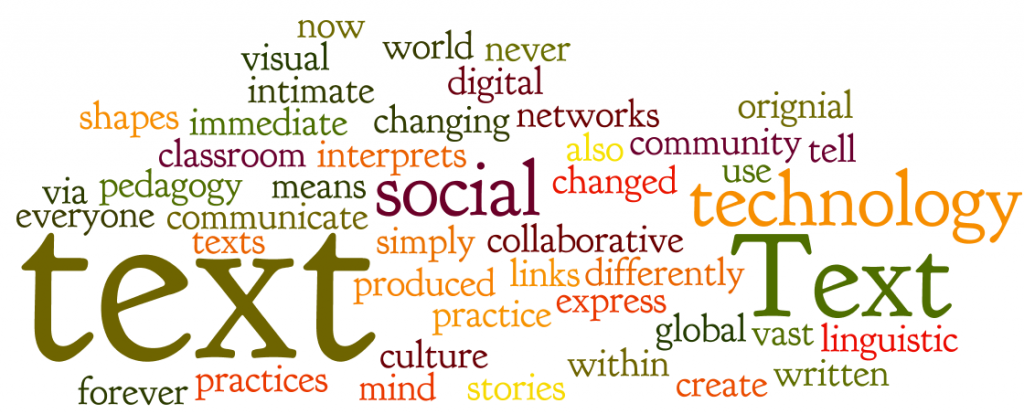I, like many of my classmates, find the resources and advice that have been shared throughout ETEC 540 to be of immense value. The conversations through Vista, Wikis, and the Weblog have captivated my attention and taught me many things. I began the course with a simplified definition of text, something that is written, and technology, a tool that aids production. Thirteen short weeks later, after reading Ong and Bolter especially, text is no longer something that is written. Text is technology, it is a thought process, it is a picture, a video, a podcast, and is represented everywhere in everything. My literacy is shaped by my culture, it is represented in my brain, and is a neurological science as much as it is a visual art.
ETEC 540 has taught me to deconstruct everything I read, and when I say read, I mean every story that is told to me, shown to me, wrote for me and wrote by me. Text is much like Web 2.0, as J. Kendell points out “with Web 2.0 we don’t just use the internet we interact with it” (Josay, n.d.). I would say that we do the same with text. We certainly don’t just read or write text, we interact with it. Through this interaction we find new ways to tell familiar stories.
As the delivery of text changes so do our expectations of text. Text is no longer a traditional medium of expression. A digital text is collaborative, visual more than it is linguistic, social and immediate. Text and technology are changing classroom practices and pedagogy. We now communicate via text with social networks from all over the world. We use technology to create links between our orignial texts and those produced within our global community of practice. The means through which we tell our stories has forever changed. Our culture shapes text, our mind express text and everyone interprets text differently. Text is intimate and text is also vast. Text will never again be simply and only, something that is written.
References
Avenia, T. (Artist). (2012). Text Word Art [Image file].
Avenia, T. (2012, Nov. 25). The history, present, and future of educational technology: Web 2.0 and beyond [web timeline]. Retrieved November 30, 2012 from http://www.tiki-toki.com/previewembed/entry/75467/0908883653/900/480/
Bolter, J.D. (2001). Writing space: Computers, Hypertext, and the Remediation of Print. [2nd Ed.]. Mahway, NJ: Lawrence Erlbaum.
Brochu, J. (2012, Nov. 24). Rix, mix, feed: Reloaded [website]. Retrieved November 30, 2012 from http://www.symbaloo.com/mix/ripmixfeedreloaded
Brochu, J. (2012, Nov. 27). Facing the web 2.0 social networks in education. [Web log comment]. Retrieved November 30, 2012 from https://blogs.ubc.ca/etec540sept12/2012/11/27/facing-the-web-2-0-social-networks-in-education/
Cavanagh, S. (2012, Nov. 25). Media as metaphor? [Web log comment]. Retrieved November 30, 2012 from https://blogs.ubc.ca/etec540sept12/2012/11/25/media-as-metaphor/
Crawford, M. (2012, Nov. 28). Educating the net generation. [Web log comment]. Retrieved November 30, 2012 from https://blogs.ubc.ca/etec540sept12/2012/11/28/educating-the-net-generation/
Francis, K. (n.d.). Getting Graphic [weebly website]. Retrieved November 30, 2012 from http://gettinggraphic.weebly.com/
Galiano, S. (n.d.). Delicious profile [social bookmarking list]. Retrieved November 30, 2012 from http://www.delicious.com/saragaliano
Hall, J. (2012, Nov. 25). Electronic books and digital information systems. [Web log comment]. Retrieved November 30, 2012 from https://blogs.ubc.ca/etec540sept12/2012/11/25/electronic-books-and-digital-information-systems/
Kendell, J. (2012, Nov. 28). Web 2.0- Not just for higher education. [Web log comment]. Retrieved November 30, 2012 from https://blogs.ubc.ca/etec540sept12/2012/11/28/web-2-0-not-just-for-higher-education/
Pena, E. (2012, Nov. 21). ernesto’s rip mix feed blogspot [web blog]. Retrieved November 30, 2012 from http://ernestosripmixfeed.blogspot.ca/
Matthews, A. (2012, Nov. 28). Technology and the resurgence of orality. [Web log comment]. Retrieved November 30, 2012 from https://blogs.ubc.ca/etec540sept12/2012/11/28/technology-and-the-resurgence-of-orality/
McQuaid. (2012, Nov. 29). Fairy Tales for Twentysomethings. [Web log comment]. Retrieved November 30, 2012 from https://blogs.ubc.ca/etec540sept12/2012/11/29/fairy-tales-for-twentysomethings/
Murray. (2012, Nov. 26). How can an educator possibly manage web 2.0 storytelling lessons amidst the vastness of the web 2.0 world? [Web log comment]. Retrieved November 30, 2012 from https://blogs.ubc.ca/etec540sept12/2012/11/26/how-can-an-educator-possibly-manage-web-2-0-storytelling-lessons-amidst-the-vastness-of-the-web-2-0-world/
Naqi, S. (2012, Nov. 25). Breakout of the billboards. [Web log comment]. Retrieved November 30, 2012 from https://blogs.ubc.ca/etec540sept12/2012/11/25/breakout-of-the-billboards-by-sheza-naqi/
Ong, W. J. (2002). Orality and Literacy [2nd Ed.]. New York: Routledge.
Penner, J. (2012, Nov. 19). Theorizing smartphone toon. Retrieved November 30, 2012 from http://www.flickr.com/photos/90118477@N05/8199833105/
Ross, T. (2012, Nov. 27). Characteristics of digital literacy [concept map]. Retrieved November 30, 2012 from http://www.gliffy.com/go/publish/4075106/
Stefanyshyn, D. (2012, Nov. 28). Web 2.0 – A dream in education. [Web log comment]. Retrieved November 30, 2012 from https://blogs.ubc.ca/etec540sept12/2012/11/28/web-2-0-a-dream-in-education/
Wernicke, A. (2012, Nov. 27). Breaking out the visual. [Web log comment]. Retrieved November 30, 2012 from https://blogs.ubc.ca/etec540sept12/2012/11/27/breaking-out-the-visual/
Whetter, A. (2012, Nov. 27). Contradictions of digital literacy. [Web log comment]. Retrieved November 30, 2012 from https://blogs.ubc.ca/etec540sept12/2012/11/27/contradictions-of-digital-literacy/



Hi Tara,
I thought this weblog post was very much an example of the work we’ve been exploring. In your creation of this blog post, you’ve demonstrated this idea of changing text.
As I read the later part of your post, I reflected on the idea of the global/virtual library which was brought up when we examined The Virtual library (O’Donnell, n.d.). New ideas of this library will need to include all the different media that you’ve included in your post and future ones too.
-Jerry
References
O’Donnell, J. (n.d.). The Virtual Library: An idea whose time has passed. Retrieved from http://web.archive.org/web/20070204034556/http://ccat.sas.upenn.edu/jod/virtual.html
Hey Tara!
I don’t think I have ever seen my name referenced before ! LOL that was too funny. I really like what you said about the connection between web 2.0 tools and text.
“I would say that we do the same with text. We certainly don’t just read or write text, we interact with it. Through this interaction we find new ways to tell familiar stories.”
I feel like this is one of the things that I have taken from this course, the ability to interact with text as I am reading and/or writing. I don’t think that I will ever think of these two things the same again!
~Julie